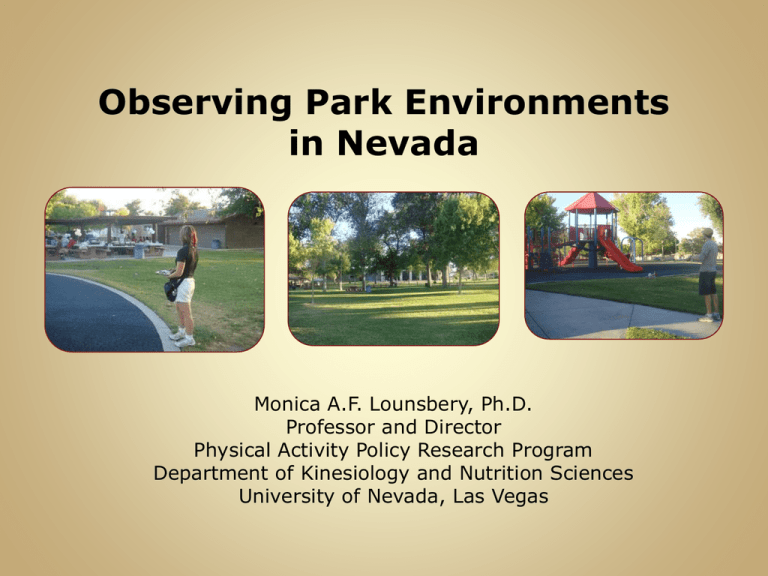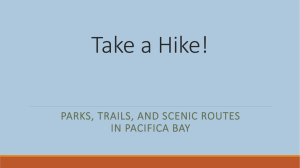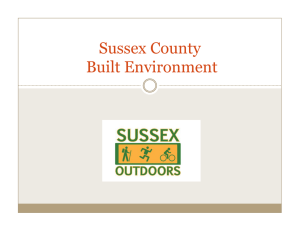Observing Park Environments in Nevada
advertisement

Observing Park Environments in Nevada Monica A.F. Lounsbery, Ph.D. Professor and Director Physical Activity Policy Research Program Department of Kinesiology and Nutrition Sciences University of Nevada, Las Vegas • This project was made possible through – The vision and recommendation of the PA Policy Research Program’s Community Advisory Board – The leadership and commitment of Melissa Clary and Susie Quintana from the City of Las Vegas and especially, Justin Williams and Bruce Sillitoe from the Clark County Comprehensive Planning Department – Funding from UNLV College of Education and The Lincy Institute The relationship of physical activity to a variety of health conditions has been well-documented – Several cohort studies showed a 30-40% increase in risk for Diabetes due to physical inactivity – Approximately 30 studies showed an inverse association between physical activity and colon cancer – Inactivity is related to 200-300K preventable deaths each year in the United States – In 2004, the World Health Organization found that physical inactivity was responsible for an estimated 3.2 million deaths Deaths Attributed to 19 Leading Factors, by Country Income Level, 2004 Physical inactivity is a leading risk factor for morbidity and mortality… Troiano R, Berrigan D, Dodd K, et al. “Physical Activity in the United States Measured by Accelerometer.” Medicine & Science in Sports & Exercise, 40(1): 181–188, January 2008. This data was measured by accelerometers. Guided by theories that emphasize psychological & social influences Primary goals have been education and behavior change skills J. Sallis Active Living Research Policy Context Physical Environment Social/Cultural Individual Biological Psychological Behavioral Skills Communities and Transportation Facilities School and Occupation Settings Recreation Facilities 8 Parks and Access to Them Matter! Gordon-Larsen P, Nelson M, Page P, et al. “Inequality in the Built Environment Underlies Key Health Disparities in Physical Activity and Obesity.” Pediatrics,117(2): 417– 424, February 2006. Las Vegas ranked 43rd among the largest 50 metropolitan cities*** 4.2% of city land is designated to parks compared to 10.6% nationally 5.5 acres of parkland per 1,000 citizens compared to 18.9/1,000 nationally Other major park, physical activity, and health disparities in Las Vegas compared to other US cities include: Lower percent bicycling or walking to work Lower requirement for physical education Per capita Las Vegas has Fewer ball diamonds Fewer park playgrounds Fewer park units Fewer tennis courts *** in preventive health behaviors, levels of chronic disease conditions, health care access, and community resources and policies that support physical activity. Research has Shown that Accessibility Disparities Medium to high income neighborhoods have significantly greater relative odds of having 1 or more park facilities compared to low income and highminority neighborhoods Inequality in availability of PA facilities may contribute to ethnic and SES disparities in PA and overweight patterns PARKS Important locations for population physical activity especially for low-income families, children, and seniors they are free and OPEN to everyone Seldom viewed as health resources or assessed on the physical activity they provide Physical activity studies have not been conducted in Nevada parks or trails health impacts have not been translated into local government services In lower income Las Vegas neighborhoods, how are parks/trails being used? How are parks perceived by the residents? How can we optimize the public’s investment in parks and trails for health related purposes? 13 City of Las Vegas Bunker Leavitt Lone Mountain Trail Clark County Desert Breeze Doc Pearson Paradise West Flamingo Wetlands Trail I-215 Beltway South and West Trails Park Bunker Desert Breeze Doc Pearson Leavitt Paradise West Flamingo Park Bunker Desert Breeze Doc Pearson Leavitt Paradise West Flamingo Acres Total population In Zip Code 21 119 8 18.4 21 15 52,317 55,456 45,095 33,533 23,334 47,080 Median Household Income % Unemployed % Minority $76,700 $61,619 $65,933 $40,100 $59,771 $42,839 6.3% 5.5% 6.7% 8.3% 6.3% 7.3% 41.1% 41.0% 61.8% 68.5% 41.1% 58.4% Trails 215 - South 215 - West Lone Mountain Wetlands Trails Total population % Female 60,009 50,132 37,776 48,678 50.1% 50.6% 50.7% 49.9% % Over 65 years of age 10.6% 10.8% 10.5% 16.0% Median Household Income Renter Occupied Percent Minority 215 - South $69,199 31.8% 44.2% 215 - West $67,809 37.6% 53.3% Lone Mountain $62,270 42.9% 41.7% Wetlands $49,697 40.6% 52.8% Direct Observation - SOPARC (System For Observing Physical Activity and Recreation in Communities; McKenzie et al., 2006) Intercept interviews with randomly selected park users Questionnaires and focus groups with residents living within .5 miles of parks • • Data were collected on 12 clement days in each environment over one year Each day, data were collected during 4 time periods (7:30am, 12:30pm, 3:30pm, and 6:00pm) • 480 area visits • IOA data were collected on 10% of the observations • Percent agreement ranged from 92%-100% 18 Invitations to complete an on-line questionnaire were sent to randomly selected residences within .5 mi of study parks Interviews were conducted with park users in all 6 parks These efforts yielded 215 completed surveys/ interviews Park users and residents were invited to participate in focus group meetings We conducted 10 focus group meetings (5 to 8 participants) Trails Parents Hispanics Senior Adults Women We audio and video recorded focus group meetings Data were transcribed and were coded 28% 19% 16% 13% 10% 8% 4% 2% 36% 24% 11% 8% 5% 8% 4% 4% 30% 22% 19% 12% 12% 5% 38% 27% 22% 8% 3% 2% 50 43% 42% 40 % of Park Users 35% 33% Morning 31% 30 28% 26% 24% 27% 25% 23% Lunch 21% 20 Evening 15% 13% 10 8% 6% 0 Children Teens Adults Afternoon Seniors 50 45 40 35 30 25 20 15 10 5 0 2% 1% 4% 21% Adult 15% 10% Teen 10% 7% 6% 5% Oct - Feb 8% March - May Senior 11% June - Sept Child Trail Trail Users (N=817) 7:30am 12:30pm 3:30pm 6:00pm 215 - South 126 51 18 26 31 215 - West Lone Mountain 84 230 28 43 11 46 31 90 14 51 Wetlands Total 377 817 95 217 116 191 103 250 63 159 Trail Trail Users (N=817) Winter Spring Summer 215- South 126 27 41 58 215 – West 84 33 24 27 Lone Mountain 230 97 71 62 Wetlands 377 230 0 147 Total 817 387 136 294 87% 62% 88% 65% 58% 42% 38% 55% 53% 47% 45% 55% 51% 50% 49% 45% 35% 13% 12% 98% 97% 3% 4% Safety from the sun and hot temperatures was perceived as a barrier Most people felt parks were well maintained and clean but some felt there were disparities in low income neighborhoods Most people felt safe although increased roving security was frequently recommended Women and parents had safety concerns about park use in the evening. % of Park Users & Non-Users 70% 62% 60% 50% 40% 31% 30% 20% 7% 10% 0% Very Safe Safe Not Very Safe 47% 20% 19% 6% 4% 3% 1% % of Park Users & Non-Users 60% 50% 50% 40% 34% 30% 19% 20% 21% 19% 16% 13% 10% 10% 0% 6% 1% 1% 5% 5% 5% 1% 2% 1% 1% 12% Most people learned about parks by driving around Some learned about parks by word of mouth Some parents learned about park programs through schools Top recommended sources of communication Apartment complex managers Post cards or mailers Schools Survey results showed that household income was found to be a significant characteristic distinguishing park users and non-users with park users more likely than non-users to have lower income (p =.024) Critical venue for addressing health disparities More males and adults use parks and trails Most people were observed sedentary parks; high moderate to vigorous PA on trails Males were more active than females Parks are rarely organized or supervised Opportunities for park programming In parks, females and seniors were relatively underserved Women emphasized time challenges as primary barriers Seniors felt unsafe being in the park with other age groups; Hispanics felt most comfortable around other Hispanics It appears that strategies for increasing PA in parks for busy adults, especially women, should focus on creating time efficiencies For those coming to parks to supervise (children or dogs) or to be spectators, some time inefficiencies could be addressed by the redesign of park facilities to include walking paths around the perimeters of park spaces Strategic programming offered programs for kids and parents in adjacent park spaces during the same frame Increasing number of programs that appeal to females, seniors and Hispanics Trail use highly active but very low use observed During focus group meetings, participants identified that use barriers were trail connectivity knowledge We speculate that observed low use was also due to the newness of the all of the trails in this study, and their general lack of promotion to the general public. Focus group participants identiycling enthusiasts are likely to be the most informed about trails in Las Vegas and in order for trails to engender mainstream use across age levels, more community events such as farmers’ markets, health fairs, or artisan booths should be planned on trails. Park and Trail Promotion is needed Most people “found” parks/trails as opposed to being informed about them Promotional efforts should bear in mind the need to appeal to sense of community activities people were interested in (e.g., walking) Promotional Partners Apartment complex managers Schools Mailers -City and county policy makers and local stakeholders in planning, government, and health will be provided with an overview of the results from OPEN -OPEN results will be used to determine next steps which may include: -New strategic partnerships - Experimental research to examine the health impact of -Park redesign -Strategic programming -And/or promotion on increasing park/trails use and physical activity -Development of an active living task force Robust conversations around how we can retrofit Las Vegas communities and specific environemnts with physical activity and health in mind! I Believe in Happy Healthy Families Payne Lounsbery, Age 8 Tori Lounsbery, Age 20 And Their Right to Be Physically Active! We need sustainable and creative policy responses to make this possible! Thank You for Listening and being OPEN to Possibilities!


![’s parks! Drinking water for [your council]](http://s2.studylib.net/store/data/015536248_1-deb9fc91be22600fb864bde62cc406aa-300x300.png)